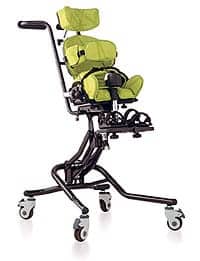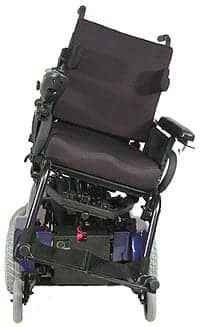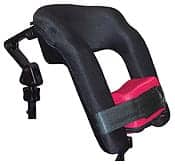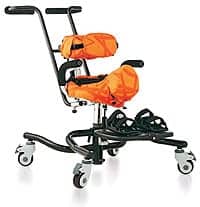 |
There are several exhibits where the latest in pediatric equipment can be viewed, including the International Seating Symposium, Medtrade, RESNA, the World Congress on Disabilities, American Physical Therapy Association Combined Sections, the American Occupational Therapy Association, and Abilities Expo—to name a few. I have had the opportunity to travel and shop around, and here is my opinion of the best in pediatric equipment for mobility, transport, and transfer.
These items are from various manufacturers (big and small), and some are offered by a few different companies. If you need help finding a specific item, please feel free to e-mail me at . As a member of Rehab Management‘s editorial board, this has been one of my most exciting assignments.
Let’s go shopping!
TRUE DYNAMIC SEATING
A new concept in seating is tension springs (think Pilates reformer meets wheelchair seating systems). What is new about these systems is that when the child moves, the system moves. It helps the child stay in the right position, no matter how active they are. The entire frame can actually move with a child’s extensor thrust, ballistic movements, rocking, and dystonia. Once the child moves out of the extreme posture, the system (which has moved with them into the extreme posture) gently guides them back to the preset range. An active or dynamic seating system enables the child to stretch at the hips and knees while maintaining proper postural alignment. When the child relaxes, they return to the proper position. These systems are also ideal for kids who rock excessively or have chorea and other movement disorders. Almost any seating system can be adapted with springs between the system and the frame. Advanced systems allow changes in spring tension and the amount of range allowed.
Do you work with a child that keeps breaking their system because of excessive movement? Then consider an active or dynamic seating system.
SIT TO STAND
RESNA has released its official “position paper” and endorsement of sit-to-stand products. Sit-to-stand products have been available for quite some time. Some models can be used as a table (desk) and chair and then, with the help of hydraulics, the squeeze of a lever enables the child to move into the standing position. Such a system makes it easy for the child to stand in short bouts and be repositioned without lifting. Now this feature can be integrated within a power mobility system. A child who needs to stand to gain access to play surfaces and functional activities such as a sink, or stand for medical reasons, can get this feature as a part of their wheelchair system.
The wheelchair-integrated power stander allows the child to drive in a standing position (slowly). Some children can use this feature to perform a stand pivot transfer with stand-by guard instead of needing maximal assistance or a lift mechanism. The time spent standing becomes a functional part of life and a way to incorporate stretching and other therapeutic activities into their daily routine. Standing can be achieved from a sitting position or, in some systems, from a horizontal one, as you would stand with a tilt table. The variety of sitting, lying, and standing position combinations allow the child’s body to move about through the day and remain comfortable and functional. The horizontal position is helpful for self-catheterization and postural drainage. Manual sit-to-stand wheelchairs are not all mobile in the standing position, but are also an excellent option for the appropriate child.
LATERAL TILT AND CORRECTING DEFORMITIES
 |
Does something look different about this chair? It’s crooked! Some “out of the box” thinking professionals have found a solution for children who cannot tolerate vertical positioning or want to be able to reposition themselves. A typical child who benefits from lateral tilt may have advanced scoliosis, a need for positional change due to pain or pressure, or a vision or vestibular issue that is alleviated with lateral positioning.
Lateral tilt enables a system to tilt 15 degrees or more in either direction. This can be used with a power option to achieve weight shifts, relieve pressure, aid transfers, and/or alleviate digestive and respiratory issues. It can be used at a fixed angle for children with severe postural deformities or vision issues such as midline shift syndrome. If used with power, this feature does not interfere with recline or posterior tilt, and usually comes with a built-in centering function. D.J. Cooper, from Sunny Hill Hospital, Vancouver, has published a review of lateral tilt systems. His abstract can be found at www.mobility2005.org.
In the past, seating systems were designed based on the child’s present condition with an eye toward changes due to surgeries, growth, and sometimes deterioration of a medical condition. New studies have shown that a seating system can be used like splints. In these systems, a program is designed to improve a child’s range of motion over time. For example, if a child has a windswept deformity, the leg and sacral supports on this chair can be moved slowly over time to try to improve the position of the trochanter and acetabulum by stretching tight muscles slowly over weeks and months. Maybe we do not have to accept hip dyslocation and subluxation as a natural by-product of tetraplegic (aka quadriplegic) cerebral palsy.
NIGHTTIME POSITIONING SYSTEMS
Another new approach is specialized positioning beds. Nighttime positioning is a key part of any 24-hour postural management program for children who cannot independently alter their position during the night and therefore are at risk of developing an asymmetric posture.
The thinking is that kids should be stretched at night and then allowed to be restrained by the least amount of straps/support possible during the day. One example of this might be to allow the child to sit with knee flexion (less than 90 degrees) to stabilize the pelvis in their chair at school to optimize arm function, but then use nighttime splinting/positioning to maintain a 6-hour stretch on the hamstrings when they sleep. Research has suggested that 6 hours is the ideal amount of time to stretch a muscle with spasticity and for children with cerebral palsy (Tardieu). Medicaid has begun (in a few states) funding special beds that allow for optimal positioning. The ideal position for sleep is comfortable, allows relaxation and sleep, and is good for the child’s body, (including digestion and respiration). These systems can support a child in almost any position. If the child’s positional needs change, then the caregiver can just change the position. The supports built into the bed ensure that the child maintained the position they are placed in while they sleep comfortably. Individual joints or the whole body can be supported to stop stronger muscles on one side of the body pulling to that side. This uneven pull can lead to asymmetry, and joints can stiffen, sometimes permanently. Manufacturers report increased sleep times and improved daytime function both physically and mentally.
THE IMPORT OF HEAD SUPPORT
 |
Leslie Fitzsimmons is a pediatric physical therapist in New Jersey. She was having trouble helping her students with severe gross motor dysfunction to keep their heads up. Leslie was determined to get appropriate equipment to solve this problem, and harassed many equipment manufacturers during her search for the perfect system. She wanted consistent positioning, safety on the bus, and a system that could not be messed up by multiple caregivers trying to “adjust” the system on their own. In the end, she developed it herself and worked with her favorite manufacturer to produce and distribute it. This amazing product acts like a therapist’s hands. By using basic stabilizing principles, it was designed to be utilized as a therapeutic tool to encourage active head control within a limited range. It offers integrated support to the entire cervical spine (posteriorly, laterally, and anteriorly if needed). There is additional support for the suboccipital and anterior upper thoracic area, which provides cuing and support to promote good alignment. This innovative head support is made to help the scapulae stay down, relaxed, and stable so that the spine can be in optimum alignment for an upright head position, while not restricting any available shoulder movement. The adjustability of the chin prompt allows for intermittent or gradual lowering of the prompt as improved head control is noted or being addressed. Leslie has successfully used this headrest for children with increased flexor tone or those too weak to hold their heads up for any sustained amount of time. She also recommends this headrest for children with extensor tone and poor midline control, especially those who often get their head caught under or to the side of their existing system.
Another leading head-support manufacturer now makes their product for infants and toddlers. This tiny headrest allows for optimal positioning so that the child can begin to improve their vision and hand-to-midline skills. Researchers are finding that vision requires head righting, and both are best developed in the first 6 months of life. If the child cannot hold their head steady, their eyes cannot work optimally. This system allows head stability with the ability to allow rotation. This headrest is one of the tiniest systems that can facilitate optimal positioning so that the child can see a toy and begin to track and ultimately reach for it.
TRANSFERS AND FUNDING
Ceiling track systems are “what’s hot.” These systems work best in new construction houses where they can be incorporated throughout the home. Cindy Thompson, a physical therapist in Tampa, Fla, switches the transfer harness for a walking harness and uses these systems to enable the child to walk in the home and classroom. These systems cannot be installed in rental properties; you need access to steel beams, and they cannot accommodate door frames (the ceiling has to be flat).
 |
For children who cannot transfer themselves from the chair to the floor, consider a chair that lowers to the floor using a power system. It was designed to enable the child to do activities both at the floor level and at table height. It can elevate from building blocks on the floor, to 17-inch standard driving seat height, to even higher—for brushing teeth, for example—in just seconds. A trick for funding is to order the chair without the “floor” feature and then seek funding for the added feature from charities or grant sources. The third-party payor funds most of the chair, but the child still gets the much needed transfer option.
In conclusion, there is a lot of way cool stuff coming out all the time. Funding is a struggle, and the child’s caregivers/team will need to be creative. Often local charities or service groups will help pay for big ticket items, especially when shown the difference it will make in that child’s life. Usually, we start with the third-party payor (health insurance), and go through a few rounds before moving on to more creative solutions. Manufacturers love it when you buy a demo product at an exhibit so the device does not have to packed and shipped home. If you see something cool, please drop me an e-mail. Have fun shopping!
Ginny Paleg, MS, PT, is a pediatric physical therapist based in Silver Spring, Md. She works for the Montgomery County Infants and Toddlers Program at the ARC Daycare Center, Rockville, Md; teaches continuing education courses; is reimbursement chair for the APTA Pediatric Section, and serves on Rehab Management’s editorial advisory board.




